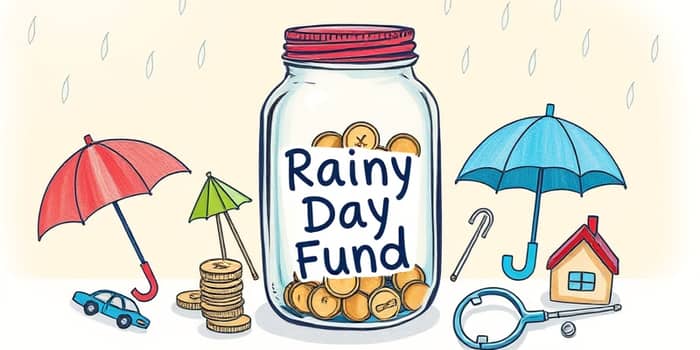Life can be unpredictable. From a sudden car repair to an unexpected medical copay, small expenses have a way of disrupting even the most disciplined budget. By setting aside a dedicated pool of cash, you can weather those minor storms without sacrificing your long-term financial goals. In this guide, you’ll discover how to establish a first line of defense against everyday surprises and build confidence in your money management.
What Is a Rainy Day Fund?
A rainy day fund is a small, easily accessible reserve of money designed to cover small, unexpected expenses such as minor car repairs, home appliance replacement, or routine vet bills. Unlike a larger emergency fund—aimed at covering months of living expenses—this fund targets everyday setbacks that don’t qualify as a full-blown crisis.
Its principal objective is to absorb minor financial shocks without reaching for high-interest credit or dipping into long-term savings. By handling these “hiccups” early, you maintain momentum on bigger financial goals such as paying off debt or investing.
Why a Rainy Day Fund Matters
Building a rainy day fund may seem like a small step, but its impact is profound. It empowers you to:
- Preserve your credit score by avoiding last-minute loans or credit card debt.
- Maintain progress on long-term goals without interruption.
- Reduce anxiety about routine expenses and cultivate financial resilience.
When you have funds set aside, you’ll approach unexpected bills with calm assurance rather than stress.
Common Expenses Covered
Every household faces unique surprises, but some scenarios are nearly universal. Your rainy day fund can step in for:
- Minor medical copays and urgent dental visits.
- Car maintenance, such as tire replacement or brake services.
- Small home repairs, from fixing a leaky faucet to resetting a HVAC filter.
- Unexpected school or activity fees for children.
- Pet emergencies, like vaccinations or minor injuries.
By anticipating these costs, you turn potential panic into manageable budgeting decisions.
Rainy Day Fund vs Emergency Fund
Understanding the distinction between a rainy day fund and a full emergency fund is key to effective saving. The former is your quick-cash solution for everyday surprises; the latter is a deeper reserve for life’s major turns.
Steps to Build Your Fund
Establishing a rainy day fund requires intention and consistency. Follow these steps to get started:
- Start small: Even $25 per month adds up over time and builds momentum.
- Set a target: Aim for an initial goal of $500, then gradually raise it to $2,000.
- Automate deposits: automate transfers on a monthly basis to remove the temptation to spend.
- Track your progress: Visual aids like a savings chart can motivate you to stay on course.
- Celebrate milestones: Every $100 or $500 increment is evidence of meaningful progress toward financial security.
Consistency is more important than the size of each deposit. Over time, your fund becomes a reliable safety net.
Choosing the Right Account
Selecting the right place to hold your rainy day fund can enhance its growth while ensuring you have access when needed. Consider a high-yield savings account or a money market account. These offer competitive interest rates and remain highly liquid.
Keeping your fund separate from everyday checking prevents accidental spending and supports separate accounts for clear budgeting. Look for FDIC-insured institutions with no monthly fees and minimal withdrawal restrictions.
Psychological and Practical Benefits
Beyond the numbers, maintaining a rainy day fund delivers emotional dividends. You’ll experience reduced stress when facing unexpected bills, knowing you have a cushion. This sense of preparedness often leads to better decision-making in other areas of personal finance, fostering a virtuous cycle of responsible habits.
Additionally, watching your fund grow—even by small increments—builds confidence and establishes a foundation for tackling larger goals, such as debt reduction or investing.
Pitfalls to Avoid
While building a rainy day fund is straightforward, certain missteps can hinder your progress:
• Relying on credit cards or payday loans to cover routine costs. High interest can quickly wipe out any short-term gain.
• Mixing rainy day funds with long-term investments. Using a retirement account for minor expenses defeats the purpose of compound growth.
• Skipping deposits when cash is tight. Even small transfers keep the habit alive and prevent the fund from stalling.
Action Steps for Today
You don’t need to wait for the perfect moment. Take these simple actions right now:
1. Open a dedicated savings account or designate an existing one as your rainy day reserve.
2. Set up an automatic transfer—start as low as $10 if needed.
3. Calculate your most common small expenses to refine your target amount.
4. Track your balance weekly and celebrate each milestone.
5. Share your goal with a friend or family member for accountability.
By committing to these steps, you’ll create a highly accessible liquid savings vehicle that safeguards your monthly budget and nurtures long-term financial resilience.
In the unpredictable journey of life, a rainy day fund offers a stable umbrella. With each deposit, you’re not just saving money—you’re cultivating confidence, reducing stress, and paving the way for a secure financial future.
References
- https://www.bankrate.com/banking/savings/what-is-a-rainy-day-fund/
- https://www.pnc.com/insights/personal-finance/save/what-is-a-rainy-day-fund.html
- https://www.westernsouthern.com/personal-finance/what-is-a-rainy-day-fund
- https://empeople.com/learn/empeople-insights/rainy-day-fund-vs-emergency-fund/
- https://www.chase.com/personal/banking/education/budgeting-saving/rainy-day-fund
- https://www.academybank.com/article/rain-or-shine-emergency-funds-for-rainy-days
- https://bethkobliner.com/advice_basics/rainy-day-fund-is-a-peace-of-mind-fund/
- https://en.wikipedia.org/wiki/Rainy_day_fund










